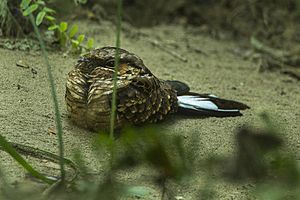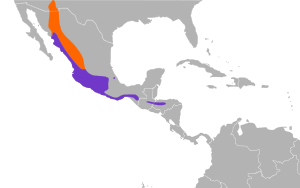Buff-collared nightjar facts for kids
Quick facts for kids Buff-collared nightjar |
|
|---|---|
 |
|
| Conservation status | |
| Scientific classification | |
| Genus: |
Antrostomus
|
| Species: |
ridgwayi
|
 |
|
| Synonyms | |
|
Caprimulgus ridgwayi |
|
The buff-collared nightjar (Antrostomus ridgwayi) is a small bird that is mostly active at night. It's known for its special song and a unique collar around its neck.
These birds are dark with cool patterns of brown, gray, black, and white on their backs and chests. Their tails are dark brown with faint stripes. You can tell the difference between male and female nightjars by their tail tips! Males have large white tips on their three outer tail feathers, while females have buffy (light yellowish-brown) tips. This helps tell them apart from their close relative, the Whip-poor-will. The buff-collared nightjar also has a clear buff-colored collar around its neck. Its song is very distinct, sounding like an accelerating "cuk, cuk, cuk, cuk, cuk, cukacheea!"
Contents
Where They Live and Make Their Homes
Buff-collared nightjars live in open areas of Mexico and Central America, reaching as far south as central Nicaragua. In the north, their home stretches just across the Mexican border into southeastern Arizona and southwestern New Mexico. These areas are part of the Madrean Sky Islands, which are mountain regions in the eastern Sonoran Desert. They are the only birds that live and breed in these northern areas all year round.
When it's time to lay eggs, nightjars don't build a nest. Instead, the female lays her two eggs right on the bare ground, often near rocks or small bushes. If a predator or person gets too close to the eggs or young birds, the adult nightjar might pretend to be hurt. This trick helps distract the intruder and keep the babies safe!
What They Eat and Do
Buff-collared nightjars are amazing hunters! They catch flying insects right out of the air. They often fly out from the ground, a bush, a tree, or a large rock to grab their prey.
Even though they are called "nightjars," meaning they are mostly active at night, you might also see them flying around at dawn or dusk. During the day, they usually rest quietly on the ground, blending in with their surroundings.
Why They Are Called That
The buff-collared nightjar used to be known as Ridgway's whip-poor-will. Its scientific name, Antrostomus ridgwayi, was chosen to honor Robert Ridgway. He was an American ornithologist (a scientist who studies birds) in the 1800s.
See also
 In Spanish: Chotacabras tucuchillo para niños
In Spanish: Chotacabras tucuchillo para niños


